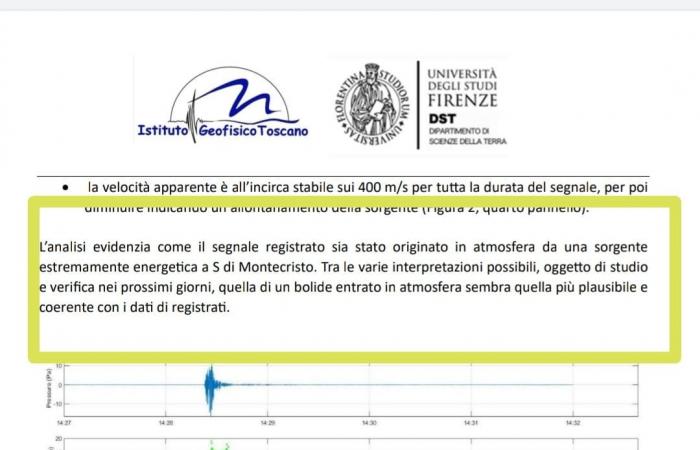Yesterday afternoon a loud bang was heard on the Tuscan coast. At first we thought it was an earthquake, but it happened the National Institute of Geophysics and Volcanology (INGV) itself to exclude tremors occurred around 4.30pm in the area.
The main hypothesis seems to be one meteor came into contact with the atmosphere south of Monte Cristo. According to Marco Morelli, head of the Tuscan Geophysical Institute, considering the energy released, height and trajectory, it could have been a fireballnot visible due to the sirocco haze, and in any case mainly due to the presence of sunlight.
Furthermore, a report was published drawn up by the Tuscan Geophysical Institute, with the University of Florence (Earth Sciences department) and with the National Institute of Geophysics and Volcanology, with data processed by Andrea Fiaschi: “At 4.29pm, the seismo-acoustic station installed at the Seccheto sports field (Campo nell’Elba) recorded an acoustic seismic signal, coinciding with a roar felt by the population. The recorded signal appears to have an amplitude ten times greater than the events previously recorded, saturating the infrasonic sensors and producing a seismic signal recorded both on Elba and on the stations of the INGV national network“.
Initial analyzes by the Geophysical Institute revealed that the signal reached the maximum recordable pressure of the sensor, i.e. 25 Pa peak-to-peak; the direction of origin is generally towards the South, thus identifying a moving acoustic source with a trajectory ranging from 70° (East) to 280° (West) with respect to the seismo-acoustic station; the apparent speed is approximately stable at 400 m/s for the entire duration of the signal, and then decreases, indicating a movement away from the source.
The preliminary analysis “highlights how the recorded signal originated in the atmosphere from an extremely energetic source south of Montecristo. Among the various possible interpretations, which will be studied and verified in the coming days, that of a fireball entering the atmosphere seems the most plausible and consistent with the recorded data“, concludes the report.
What is a fireball
A fireball it is commonly understood as a body coming from space and which, falling into the atmosphere, appears as a ball of fire followed by a trail of light. Normally the fireball is a meteoritethat is, a fragment of rock generally originating from a comet or an asteroid which, passing close to the Earth, is attracted by the gravitational field of our planet, therefore falling towards the ground.
The fireball, upon entering the atmosphere, catches fire due to friction and is consumed by evaporation as it proceeds towards the ground. If its mass is sufficiently large, it manages to reach the ground or very close to it, as on 15 February 2013 in Chelyabinsk in Russia where a meteorite with a diameter of around 19 meters and weighing around 10,000 tonnes entered the atmosphere, shattering a few dozen of kilometers above the Russian city of Chelyabinsk. The impact of the space rock with the atmosphere caused a violent explosion (27 times more powerful than the nuclear bomb that destroyed Nagasaki) with a shock wave over a vast area, which also included the Russian city where there was damage very serious and hundreds injured due to the explosion of the windows of the houses and the collapse of the roof of a large warehouse.
Very famous too the episode of March 2015 in the heart of Europe.
The fireballs can have different colors, which can also depend on their composition, but which are essentially related to the temperature reached. Colors towards violet (white or blue) correspond to higher energies and higher temperatures, while colors towards yellow and red correspond to lower temperatures and lower energy levels (for further information on the colour-temperature correspondence, see this article).
It must be said that any fragment of an artificial satellite falling into the atmosphere would also appear like a fireball. Therefore, in scientific terms we prefer to speak of meteors and of meteorites. Meteors are very small fragments of various celestial bodies scattered throughout space that become visible when the Earth encounters them during its orbit around the Sun, producing the phenomenon known as “shooting stars”. The phenomenon can occur randomly and without warning, being generated by sporadic meteors that cannot be classified in any way. But some “shooting stars” are meteors produced by the disintegration of ancient comets and appear periodically when the Earth intersects the orbit of the original comet, that is, once a year. Traditionally grouped in swarms, they are named after the constellation from which they seem to “come” when they become visible, like the Perseids and the Orionids.
Meteorites, on the other hand, are fragments of larger celestial bodies, with a mass large enough to manage not to evaporate completely during their journey through the atmosphere and therefore to reach the ground, accompanied by an explosion and producing a crater whose dimensions depend on their size. mass and their speed at impact.
Continue reading on MeteoWeb




